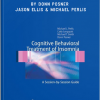CBT for Insomnia by Donn Posner , Jason Ellis & Michael Perlis
$67.00
Content Proof
File size:
- Description
Description
CBT for Insomnia by Donn Posner , Jason Ellis & Michael Perlis
Get CBT for Insomnia by Donn Posner , Jason Ellis & Michael Perlis with bestoftrader.com
Description
The clinical practice guideline released by the American College of Physicians (ACP) in 2016 highlights the recommendation based on clear evidence on the efficacy of CBT-I in treating insomnia, while also improving co-occurring disorders.
Be part of the solution! Now, you can advance your practice with specialized training in the cognitive behavioral treatment of insomnia – online from the convenience of your home or office.
This new online CBT-I training course, which features today’s leading experts on CBT-I and Behavioral Sleep Medicine (BSM), offers a clear, systematic session-by-session approach that is proven to effectively treat insomnia – long after treatment has ended.
In addition to the intensive training on CBT-I, you’ll also learn about the medical management of insomnia and the requirements for practicing Behavioral Sleep Medicine.



• Insomnia treatment options
• Sleep stages
— Functions of sleep
— How much sleep individuals need
— Sleep need, sleep ability, and sleep opportunity
• Intrinsic sleep disorders
This module will answer that difficult question, as well as examining:
• “Does worry keeps one awake, or does one worry because one is awake?”
— The nature of insomnia over time
— Why sleep extension is a problem
— Why sleep restriction works
• Pros and Cons of the following medications:
— Benzodiazepines
— Imidazopyridines
— Melatonin Agonists
— Tricyclics
— Antidepressants
• Pros and cons for each treatment modality
• Comparison of medical and behavioral interventions
• How to determine who is a good candidate for CBT–I
— Assessment tools
Module 4 outlines:
• CBT-I Session by Session break-down:
— Session I: Intake Evaluation
— Session II: Treatment Initiation, Sleep Restriction and Stimulus Control Procedures and Rationale
— Session III: Sleep Hygiene
— Session IV, V, & VI: Titration and Compliance
— Session VII: Cognitive Therapy for Insomnia Related Catastrophic Thinking
— Session VIII: Relapse Prevention
• How to handle client arguments about sleep restrictions
— “I wanted to, but I couldn’t”
— “I didn’t want to”
— “I did it” (but they’re lying)
• Practice management & billing
Michael L. Perlis, Ph.D., is internationally known for his work in Behavioral Sleep Medicine (BSM) and is the primary speaker in this course. He is a coauthor of the first text book in this field and he is the senior author of a published CBT-I treatment manual and a larger text summarizing all BSM treatments. His research includes neurocognitive phenomena in insomnia, the cognitive and/or behavior effects of sedative hypnotics and placebos, the development of alternative treatment approaches for insomnia, and sleep in depression. He has published more than 100 articles and chapters on the sleep research related topics. Learn more about Michael L. Perlis, Ph.D.
Donn Posner, Ph.D., brings a hands–on perspective to the course, highlighting what brings CBT–I therapy to life and what works for insomnia patients. He has been actively engaged in the treatment of sleep-disordered patients for the past twenty-one years. He sees a wide variety of patients, including those with Primary and Co-Morbid Insomnia, Circadian Rhythm Disorders, Sleep Apnea, and Narcolepsy. Learn more about Donn Posner, Ph.D.
Jason Ellis, Ph.D., is an international sleep researcher and CBT–I therapist. His hands–on perspective resolves common issues that arise when implementing CBT–I. Jason is a Professor of Sleep Science and Director of the Northumbria Centre for Sleep Research in the United Kingdom. He splits his time between his basic research interests: the pathophysiology of sleep disorders (Insomnia, Restless Legs Syndrome, and Circadian Rhythm Disorders), the natural history of Insomnia, and his applied work on Cognitive Behavioral Therapy for Insomnia (CBT-I). Learn more about Jason Ellis, Ph.D.
More information about Medical:
Medicine is the science and practice of establishing the diagnosis, prognosis, treatment, and prevention of disease.
Medicine encompasses a variety of health care practices evolved to maintain and restore health by the prevention and treatment of illness.
Contemporary medicine applies biomedical sciences, biomedical research, genetics, and medical technology to diagnose, treat, and prevent injury and disease,
typically through pharmaceuticals or surgery, but also through therapies as diverse as psychotherapy, external splints and traction, medical devices, biologics, and ionizing radiation, amongst others.
Medicine has been around for thousands of years, during most of which it was an art (an area of skill and knowledge) frequently having connections to the religious and
philosophical beliefs of local culture. For example, a medicine man would apply herbs and say prayers for healing, or an ancient philosopher and physician would apply bloodletting according to the theories of humorism.
In recent centuries, since the advent of modern science, most medicine has become a combination of art and science (both basic and applied, under the umbrella of medical science).
While stitching technique for sutures is an art learned through practice, the knowledge of what happens at the cellular and molecular level in the tissues being stitched arises through science.















